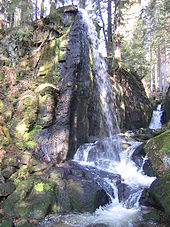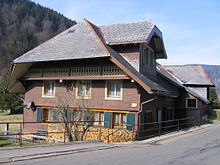Menzenschwand
|
Menzenschwand
City of St. Blasien
|
|
|---|---|
| Coordinates: 47 ° 49 ′ 4 ″ N , 8 ° 4 ′ 14 ″ E | |
| Height : | 863 m |
| Residents : | 566 (May 1, 2017) |
| Incorporation : | July 1, 1974 |
| Postal code : | 79837 |
| Area code : | 07675 |
|
Upper Albtal with terminal moraines of the Kluse (front), step to the Krunkelbach valley floor (middle) and Hinterdorf
|
|
Menzenschwand is a climatic health resort . The place is part of the city of St. Blasien in the Black Forest in Baden-Württemberg .
geography
Menzenschwand consists of three village centers, Vorderdorf , Mitteldorf and Hinterdorf , and with just under 550 inhabitants belongs to the town of St. Blasien in the Waldshut district . It is located in the valley of the Menzenschwander Alb , which descends from the 1493-meter-high Feldberg to the south and joins the Bernauer Alb above St. Blasien to the west . The Schluchsee lies in the eastern neighboring valley .
The valley landscape of Menzenschwand is characterized by glacial streams from the Feldberg glacier from several ice ages . The main glacier, which is more than 300 meters thick, was taken up by the trough-shaped Krunkelbach valley, which begins to the west of the Herzogenhorn with nested large Karen . The south-facing Alb valley flows into the Krunkelbachtal in a small valley step about 20 meters high. The Alb has cut a gorge with small waterfalls (one of them artificial). A little above a striking terminal moraine wall crosses the valley. The narrow breakthrough point of the stream, the Menzenschwander Kluse , was previously used as a damming for the log drift . The basin-shaped mouth area is a condensed, former lake. Numerous round humps characterize the meadows on the lower slope areas.
West of the rear village is located in a Kar under the Spießhorn ( 1350.8 m ) the circular Scheibenlechtenmoos , a mountain bog . Valuable small moors of various stages of development can also be found in the summit area of the Bärhalde to the north.
Large parts of the district belong to the Feldberg nature reserve .
history
The first written mention comes from the year 1328.
Livelihoods have always been animal husbandry and wood processing in homework as carving (Schneflerei), wood turning , wooden basket making. The part-time work became increasingly necessary due to the increasing fragmentation of land in the real division area of the St. Blasien monastery .
By 1770, most of the community's forests had fallen victim to logging. The wood was rafted to the Upper Rhine .
Around 1910, Otto Hüglin , the builder and owner of the St. Blasien Kurhaus, planned a large-scale project with a luxury hotel in Menzenschwand and a private rail link over the Feldberg. The project was not implemented.
With the regional reform in Baden-Wuerttemberg , with effect from January 1, 1973, the previously independent community of Menzenschwand, district of Hochschwarzwald , was added to the district of Waldshut . On July 1, 1974, it was incorporated into the city of Sankt Blasien .
Economy and Transport
Agriculture
As a valley area, Menzenschwand is largely characterized by part-time farming (cattle and dairy farming, including contractual nature conservation ).
tourism
The main source of income, however, is tourism with accommodation establishments, holiday homes and specific services. Today's place sees itself primarily as a winter sports resort in the Feldberg ski area. In the village there is a ski jumping stadium with two jumps (in winter evenings with floodlights), three lifts in the local area (one free of charge) and five on the Feldberg, as well as the largest Nordic walking network in Germany. Radon therapy is a newer offer .
Mining
There is a rich uranium deposit in Menzenschwander Krunkelbachtal. Uranerz was mined from 1961 to 1991, but officially the Krunkelbach mine was only a “uranium exploration company”, the main purpose of which was to be exploration and not mining. After mining ended in July 1991, the pit sank completely by the end of the year. The land took over the recultivation of the heaps. Due to radon-containing water from the disused mine, the first radon bath in the Black Forest was opened on October 9, 2005 in Menzenschwand, the Menzenschwand Revital bath .
Menzenschwand can be reached from St. Blasien or via a road that branches off from federal highway 500 at the village of Aha am Schluchsee , which is partially only accessible in winter.
Attractions
- Townscape with several ensembles of well-preserved Black Forest houses
- Feldberg summit area
- Herzogenhorn summit area
- Wildlife on the steep alpine slopes (including chamois, birds of prey)
- Gorge and waterfalls of the Menzenschwander Alb below the Menzenschwander Kluse (see also list of waterfalls in Germany )
- Raised bog, Scheibenlechtenmoos, in a cirque under the Spießhorn
- Le Petit Salon with Winterhalter exhibition
Culture
Churches
Since 1308 the Catholic community - today: St. Martin - has been looked after by the Benedictine monks in St. Blasien. In 1604 a chapel was built in the Vorderdorf, today's Sebastian Chapel, which was followed by a new church in the Hinterdorf in 1687/88.
In 1975 a new parish center and a new parish church were built, which were consecrated on May 30, 1976 by Auxiliary Bishop Karl Gnädinger . Since October 2003 the parish of St. Martin, together with the parish of Herz-Jesu, Albtal and the parish of St. Blasius, has been part of the St. Blasien pastoral care unit .
The church in the rear village is now used by the Protestant parish of St. Blasien.
Personalities
The portrait painter and lithographer Franz Xaver Winterhalter was born in Menzenschwand, as was his brother Hermann Fidel Winterhalter (1808–1891).
The painter Hildegard von Bylandt-Rheydt lived in Menzenschwand from 1929.
The disabled athlete Alexander Spitz (* 1968), who won a total of 12 gold, 5 silver and 3 bronze medals at world championships and Paralympics in alpine skiing between 1984 and 1994 , is based in Menzenschwand and a member of the Menzenschwand Ski Club.
literature
- Frank Bode: Sub-recent vegetation and landscape change in the southern Black Forest. Investigated using the example of the Menzenschwander Valley . Dissertation, University of Freiburg 2005, urn : nbn: de: bsz: 25-opus-26477
- Hubert Mayer, Michael Ehlert: Chronicle Menzenschwand. History of a Black Forest village . City administration, St. Blasien 2000, ISBN 3-00-007141-5 .
- Armin Simon: The dispute over the Black Forest uranium. The dispute over uranium mining in Menzenschwand in the southern Black Forest 1960–1991 . In: Arbeitskreis Regionalgeschichte Freiburg eV (Ed.): Everyday life & province . tape 11 . Donzelli-Kluckert Verlag, Bremgarten 2003, ISBN 3-933284-11-2 .
Individual evidence
- ↑ Numbers data facts on the St. Blasien website , accessed on March 17, 2019
- ^ Federal Statistical Office (ed.): Historical municipality directory for the Federal Republic of Germany. Name, border and key number changes in municipalities, counties and administrative districts from May 27, 1970 to December 31, 1982 . W. Kohlhammer, Stuttgart / Mainz 1983, ISBN 3-17-003263-1 , p. 523 .
- ^ Mineralienatlas.de : Mineralienatlas Lexikon - Germany / Baden-Württemberg / Black Forest / Menzenschwand / Krunkelbach , accessed on June 11, 2008
- ↑ Home - Le Petit Salon. Retrieved June 22, 2016 .
- ↑ Karin Steinebrunner: St. Blasien: Bilder der Heimatliebe , Badische Zeitung, July 2, 2012, accessed on July 20, 2012
- ↑ Overview of sports ambassadors. Application company Munich 2018 GmbH, archived from the original on October 19, 2010 ; Retrieved May 19, 2013 .
- ^ Rolf Kunkel : The nevertheless athletes , in: Die Zeit, 1998










